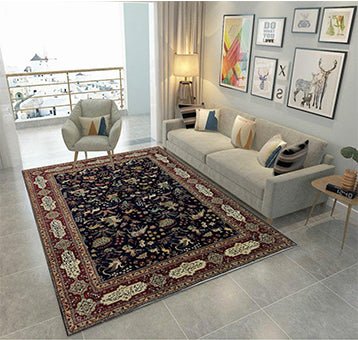Oriental rugs are renowned for their intricate designs, rich history, and exceptional craftsmanship. These rugs have been prized possessions for centuries, adding elegance and cultural significance to homes around the world. In this comprehensive guide, we'll delve into what makes an Oriental rug, its history, various styles, and how to identify one. At RenCollection Rugs in Dallas, TX, we offer an exquisite selection of handmade, handwoven, and handknotted Oriental rugs.
1. What is an Oriental Rug?
An Oriental rug is a handwoven or handknotted textile traditionally made in countries of the “Orient,” which includes regions like the Middle East, Asia, and North Africa. These rugs are known for their detailed patterns, vibrant colors, and high-quality materials. The term "Oriental rug" encompasses a variety of styles, each with its unique characteristics and cultural significance.
2. The History of Oriental Rugs
The history of Oriental rugs dates back thousands of years. Originating in ancient civilizations, these rugs were initially created for practical purposes, such as covering floors and providing warmth. Over time, they evolved into works of art, with weavers incorporating intricate designs and symbols that tell stories and reflect their cultural heritage.
3. Styles of Oriental Rugs
Oriental rugs come in various styles, each representing the region where it was made. Here are some of the most popular styles:
-
Persian Rugs: Known for their intricate floral and geometric patterns, Persian rugs are some of the most sought-after and highly regarded Oriental rugs.
-
Turkish Rugs: These rugs often feature bold colors and symmetrical designs. The use of double knots is a distinctive characteristic of Turkish rugs.
-
Afghan Rugs: Typically crafted with deep, rich colors and tribal patterns, Afghan rugs have a rustic charm and durability.
-
Chinese Rugs: Chinese rugs often showcase intricate motifs such as dragons, flowers, and landscapes, with a softer color palette.
-
Indian Rugs: Indian Oriental rugs are known for their detailed patterns and vibrant colors, often incorporating floral and paisley designs.
4. Characteristics of Oriental Rugs
Oriental rugs have several key characteristics that set them apart from other types of rugs:
-
Handmade Craftsmanship: Each Oriental rug is a unique piece of art, meticulously crafted by skilled weavers.
-
Natural Materials: High-quality wool, silk, and cotton are commonly used, providing durability and a luxurious feel.
-
Intricate Patterns: The designs often include detailed motifs, symbols, and patterns that reflect the weaver’s cultural heritage.
-
Vibrant Colors: Natural dyes are used to achieve rich, lasting colors that enhance the rug's beauty over time.
5. Identifying an Oriental Rug
Identifying an authentic Oriental rug involves examining several factors:
-
Weave and Knotting: Authentic Oriental rugs are handwoven or handknotted. The back of the rug should show the same pattern as the front, indicating it was handmade.
-
Materials: Look for high-quality natural materials like wool or silk. Synthetic materials suggest a machine-made rug.
-
Design and Patterns: Traditional Oriental rug patterns are detailed and symmetrical. Unique, intricate designs are a hallmark of authenticity.
-
Origin: Check the label or ask the seller about the rug's origin. Genuine Oriental rugs often come with documentation of their provenance.
6. Why Choose an Oriental Rug?
Oriental rugs are more than just floor coverings; they are pieces of history and art that can enhance any room. Here are a few reasons to choose an Oriental rug:
-
Timeless Beauty: The intricate designs and rich colors of Oriental rugs never go out of style.
-
Durability: Made from high-quality materials, these rugs can last for generations with proper care.
-
Cultural Significance: Owning an Oriental rug is like owning a piece of cultural heritage, each with its unique story.
-
Investment: Authentic Oriental rugs often appreciate in value over time, making them a worthwhile investment.
7. Caring for Your Oriental Rug
To maintain the beauty and longevity of your Oriental rug, follow these care tips:
-
Regular Cleaning: Vacuum gently to remove dust and dirt. Avoid using a vacuum with a beater bar on delicate rugs.
-
Spot Cleaning: Blot spills immediately with a clean, dry cloth. Use a mild detergent if necessary, but avoid harsh chemicals.
-
Professional Cleaning: Schedule professional cleaning every 1-2 years to keep your rug in top condition.
-
Rotation: Rotate your rug every few months to ensure even wear and prevent fading from sunlight exposure.
Frequently Asked Questions (FAQ)
Q: What makes an Oriental rug different from other rugs? A: Oriental rugs are distinguished by their handmade craftsmanship, high-quality natural materials, intricate patterns, and cultural significance.
Q: How can I identify an authentic Oriental rug? A: Look for handwoven or handknotted construction, high-quality materials, detailed patterns, and information about the rug's origin.
Q: Why are Oriental rugs considered valuable? A: Due to their craftsmanship, materials, and cultural significance, authentic Oriental rugs often appreciate in value over time.
